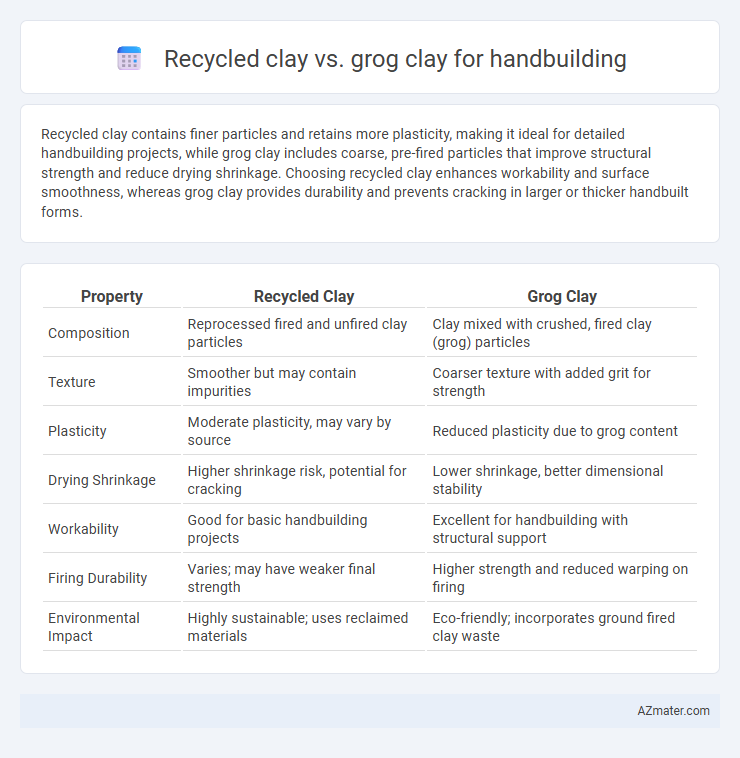Recycled clay contains finer particles and retains more plasticity, making it ideal for detailed handbuilding projects, while grog clay includes coarse, pre-fired particles that improve structural strength and reduce drying shrinkage. Choosing recycled clay enhances workability and surface smoothness, whereas grog clay provides durability and prevents cracking in larger or thicker handbuilt forms.
Table of Comparison
| Property | Recycled Clay | Grog Clay |
|---|---|---|
| Composition | Reprocessed fired and unfired clay particles | Clay mixed with crushed, fired clay (grog) particles |
| Texture | Smoother but may contain impurities | Coarser texture with added grit for strength |
| Plasticity | Moderate plasticity, may vary by source | Reduced plasticity due to grog content |
| Drying Shrinkage | Higher shrinkage risk, potential for cracking | Lower shrinkage, better dimensional stability |
| Workability | Good for basic handbuilding projects | Excellent for handbuilding with structural support |
| Firing Durability | Varies; may have weaker final strength | Higher strength and reduced warping on firing |
| Environmental Impact | Highly sustainable; uses reclaimed materials | Eco-friendly; incorporates ground fired clay waste |
Introduction to Recycled Clay and Grog Clay
Recycled clay consists of previously fired or discarded clay that has been reprocessed and reclaimed for new use, making it an eco-friendly option for handbuilding projects. Grog clay contains ground fired clay particles known as grog, which improve the clay's texture, reduce shrinkage, and increase strength during drying and firing. Understanding the properties of recycled clay versus grog clay helps potters select the right material for durability and workability in handbuilding techniques.
Key Characteristics of Recycled Clay
Recycled clay in handbuilding contains reprocessed materials that retain plasticity but may exhibit increased brittleness and reduced consistency compared to fresh clay. It often includes grog, but with finer, less uniform particle size, affecting texture and drying shrinkage, which can cause uneven warping. Recycled clay is environmentally sustainable, cost-effective, and suitable for creating rustic or textured ceramic pieces where precision is less critical.
Distinct Features of Grog Clay
Grog clay contains pre-fired clay particles that provide enhanced structural strength, reduce shrinkage, and improve thermal shock resistance, making it ideal for handbuilding techniques. Its coarse texture increases the clay body's plasticity and workability, allowing artists to create larger, more durable pieces with less cracking during drying and firing. Unlike recycled clay, grog clay offers superior durability and consistent performance due to its inert grog content.
Workability: Recycled Clay vs Grog Clay in Handbuilding
Recycled clay often has a softer texture and higher plasticity, making it easier to shape and mold in handbuilding projects, but may contain impurities that affect consistency. Grog clay contains ground fired clay particles that improve structural integrity and reduce shrinkage, enhancing workability by providing better grip and preventing cracking during drying. The presence of grog enhances durability and decreases warping, making it ideal for complex handbuilding forms requiring added strength.
Strength and Durability Comparison
Recycled clay often contains impurities and inconsistencies that can reduce its overall strength and durability compared to grog clay, which includes pre-fired clay particles that enhance structural integrity and reduce shrinkage. Grog clay exhibits superior resistance to cracking and warping during drying and firing, making it ideal for handbuilding projects that require longevity and robustness. While recycled clay is environmentally beneficial, grog clay provides a more reliable material choice for achieving durable, high-strength ceramic pieces.
Surface Texture and Aesthetic Outcomes
Recycled clay often contains impurities and inconsistent particle sizes, resulting in a rougher surface texture that can add natural, organic character to handbuilt ceramics. Grog clay, composed of pre-fired clay particles mixed into the clay body, creates a gritty texture that enhances strength and reduces shrinkage while providing a more controlled, textured surface ideal for detailed aesthetic finishes. Artists selecting between recycled and grog clay prioritize recycled for rustic, varied textures and grog for durability and precise surface control in handbuilding projects.
Drying and Firing Differences
Recycled clay often contains moisture inconsistencies that can lead to uneven drying and increased risk of cracking compared to grog clay, which includes fired particles that improve airflow and reduce shrinkage during drying. Grog clay's inclusion of pre-fired granules enhances thermal resistance and reduces warping during firing, making it more stable for handbuilding projects. Drying recycled clay requires slower, controlled conditions to prevent defects, whereas grog clay typically allows for faster drying and more predictable firing outcomes due to its improved structure.
Environmental Impact and Sustainability
Recycled clay reduces waste by reusing previously fired or unfired clay, minimizing the need for new raw materials and lowering energy consumption in production, which contributes to sustainability in handbuilding. Grog clay incorporates fired clay particles that improve texture and reduce shrinkage, promoting durability and extending the lifespan of ceramic pieces, which supports environmental goals by reducing material waste. Both options offer eco-friendly benefits, with recycled clay emphasizing waste reduction and grog clay enhancing long-term usability, making them valuable choices for sustainable ceramics.
Cost Considerations for Artists
Recycled clay offers a cost-effective option for handbuilding artists by reducing the need for purchasing new materials, making it ideal for budget-conscious creators. Grog clay, infused with granular grog, increases durability and firing strength but often comes at a higher price due to added processing. Artists must weigh the lower upfront cost of recycled clay against the enhanced structural benefits and longevity provided by grog clay when selecting materials for their projects.
Choosing the Right Clay for Your Handbuilding Project
Recycled clay offers an eco-friendly option with variable consistency, making it ideal for experimental handbuilding but requiring thorough wedging to remove impurities. Grog clay contains pre-fired clay particles that enhance texture, reduce shrinkage, and improve structural strength, making it well-suited for detailed or larger handbuilt forms. Selecting between recycled and grog clay depends on project complexity, desired surface texture, and firing requirements to ensure durability and workability.

Infographic: Recycled clay vs Grog clay for Handbuilding
 azmater.com
azmater.com